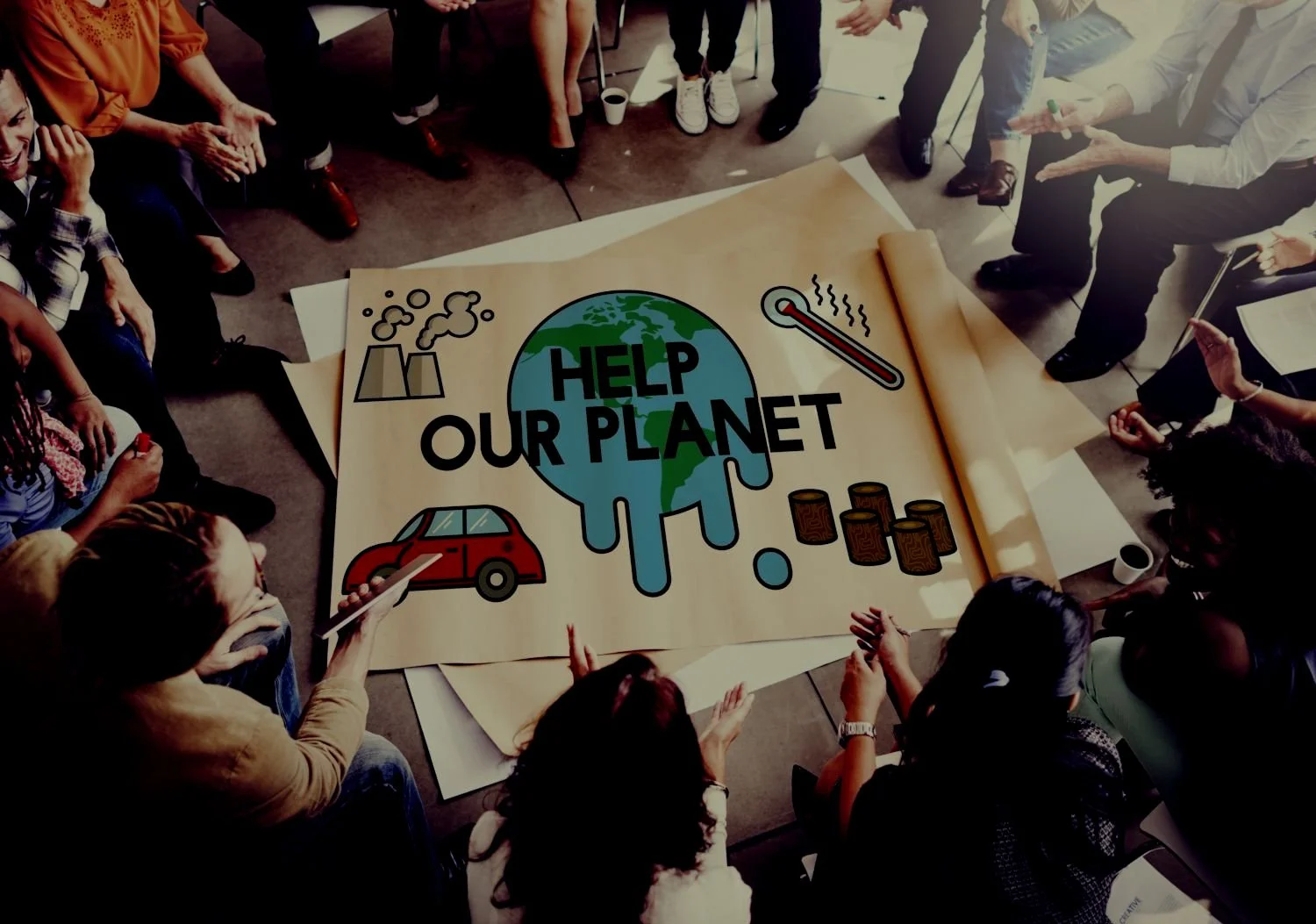February 2021
Everybody has a carbon footprint value associated with them, depending on their lifestyle. While the global average footprint of a person is close to 4 tonnes of CO₂, for a European, it is 7 tonnes.
The bad news: The more extensive your carbon footprint is, the more harmful it is to the environment.
However, the good news is that reducing your carbon footprint is easier than you might think.
We equip you with all the basic knowledge on how to do it.
WHAT IS YOUR CARBON FOOTPRINT?
The carbon footprint (or greenhouse gas (GHG) footprint) indicates the total amount of greenhouse gases emitted from any activity, product, company or country.
Carbon footprints are estimated as tons of CO₂ equivalent emissions in different units, such as per person, per product, per year, per km travelled, per protein consumed, etc.
A product's carbon footprint includes emissions for its entire life cycle, from production along the supply chain to its final consumption and disposal.
HOW TO REDUCE YOUR CARBON FOOTPRINT?
It is easier than you think to reduce your Carbon Footprint. Here is how you do so:
Get started to calculate and track your Carbon Footprint. Continue reading how to do that. ↓
Adapt your consumption behaviour towards a less CO₂-intensive consumption. We developed an easy, applicable 6-step-by-step Guide → to help you reduce your CO₂ emissions. Check it out to kick-start your sustainability journey.
Offset the CO₂ you can not avoid to emit. Keep reading; we provide some tips on how to do that. ↓
CALCULATING & TRACKING YOUR CARBON FOOTPRINT
Calculating, tracking, and reducing your carbon footprint is probably easier than you think. Plenty of mobile applications support you in monitoring your emissions and, equally important, finding ways to reduce them.
The procedure is usually as follows:
You will be asked about your consumption behaviour and your lifestyle.
You feed in information about your lifestyle, such as your consumption of commodities and electricity, transportation habits and waste generation.
The app calculates your carbon footprint.
The app provides tips and tricks on how to reduce your carbon footprint.
The app provides tools to track your carbon footprint development.
Here are a couple of platforms providing appropriate software to help you get started:
Carbon Tracer, Capture, Earth Hero, Map My Emissions, For Good, Global Footprint Network, Nature, WWF, Carbon Footprint.
2. REDUCING YOUR CO2 FOOTPRINT - RECONSIDER YOUR LIFESTYLE & PURCHASING DECISIONS
We can reduce our carbon footprint by adapting our routines and habits to almost everything we do.
We developed an easy, applicable 6-step-by-step Guide → to help you reduce your CO₂ emissions. Check it out to kick-start your sustainability journey immediately.
To inspire you on where to get started, we provide examples sorted by life areas; keep reading. ↓
3. REDUCING YOUR CO₂ FOOTPRINT - CARBON OFFSETTING
The easiest way to minimise your carbon footprint is to offset your footprint by planting trees and buying carbon credits.
Organisations such as ForTomorrow offer a CO₂ calculator and offset your carbon footprint for you.
Organisations such as sustamize.com or worldwatchers.org offer holistic offsetting concepts to companies.
EXAMPLES OF ‘HOW TO REDUCE YOUR CARBON FOOTPRINT’
To inspire you on where to get started reducing your CO₂ footprint, we compiled a list of examples sorted by life areas.
Happy Learning!
FOOD & BEVERAGES
Reduce your meat consumption
Learn about how to Enjoy Less Meat →, and introduce a weekly veggie day.
Reduce your dairy consumption.
Learn about Cow Milk Alternatives →; they are tasty!
Go vegan.
At least start with a vegan dish daily. ;) Here is all about Plant Protein → to help you get started.
Buy local, organic & in-season produce.
Buying Local →, Organic → and In-Season Produce → eliminates carbon emissions from transport and energy needed to simulate an artificial environment to grow the products off-season.Reduce your food waste.
About 1/3 of the food produced in the world goes to waste. Oh no! Here is all about Handling your Food Sustainably →Compost your kitchen waste.
Here are the basics about Composting Food → to sustainably fertilise your garden or balcony plants.
FASHION & BEAUTY
Avoid fast fashion
Avoiding fast fashion brands and choosing sustainable brands that promote sustainability and ethical labour practices will help curb climate change.
Check our Guide on Fashion Certificates → to learn how to quickly spot sustainable brands.
Buy vintage, recycled, or Second-Hand Fashion →.
The fashion industry is the 2nd-largest consumer of the world’s water. Let’s get off the game.Donate pre-loved clothes.
85% of the manufactured textile is dumped each year. Reduce the impact of clothes on the environment by Donating Your Pre-Loved Fashion Items → to charities or second-hand stores.Wash clothes at low temperatures & full load.
Studies show that laundering accounts for 60-80% of a garment’s total footprint. Wash your clothes at a lower temperature and full load to reduce the impact. Learn more about Washing Clothes Sustainably →.Line dry clothes instead of using dryers.
The dryer is your house's third most energy-consuming device after the refrigerator and the washer. Air-drying clothes can reduce a household’s carbon footprint by 2400 pounds annually.
Learn more about Drying Clothes Sustainably →.
ENERGY & ELECTRONICS
Get your heat & electricity from “green” suppliers.
Energy industries across Europe have the highest carbon footprint compared to all other sectors. The one change you can make to offset your carbon emissions is to switch to green suppliers that use renewable sources to produce it. Choosing such suppliers will allow them to become more competitive in the market and lead to reduced prices.
Here is How to Switch to a Green Energy Supplier →.Buy efficient appliances with high-energy labels.
Energy labelling of electronic appliances is pretty standardised in Europe. It goes from A (very efficient) to G (least efficient). While shopping for appliances, always check the label as an appliance with label A will be environmentally friendly because it uses less electrical input to operate.Learn about How to Shop Green Home Appliances →, check our manual entry on Sustainable Laptops →, and learn about Sustainable Smartphones →.
In the following, we list the most relevant aspects to consider.
For a comprehensive overview, check our manual entry on How to Save Energy @ Home →.
Check the energy label of your house & have an energy audit.
Energy audits are very beneficial to the environment and your heating bills. They suggest improvements that can be made to your house that will bring down your heat demands. This means fewer resources will be needed to achieve thermal comfort and, in the long run, will lead to reduced heating costs.
Use smart thermostats to regulate heating.
Thermostats contribute to regulating your heating needs. Although it may cost to have them installed in your home, you will notice better heating control that uses less heat to meet your demand, so in the long run, this investment will pay itself back.Replace lights with LEDs.
LEDs are 80% more energy efficient than regular lights. Hence, installing LEDs will lead to low power consumption and a positive impact on the environment.Improve the insulation of your house.
One significant improvement that can be made to old houses is to increase their insulation. This helps keep the heat trapped in the home longer, reducing the need for ongoing heart generation. An example is replacing old windows and balcony doors with double-glazing ones. This simple solution will keep the heat in and reduce your heating bills.Use rechargeable batteries.
Batteries are made from some toxic materials, and single-use alkaline batteries have a higher impact than rechargeable batteries. However, the rechargeable batteries need to be used in at least 50 charge-discharge cycles to offset emissions from the manufacturing process significantly offset emissions from the manufacturing process.
HOUSEHOLD HABITS
Recycle paper, plastic, glass & metal.
Recycling is one of the best solutions to reducing carbon impact. Recycling all plastic waste alone would reduce carbon emissions by 25% by 2050.Here, we compiled all the details about Waste & Recycling →.
Use less water.
Water is the most vital resource that is required for most human activities. This water needs to be treated, cleaned and pumped to its destination, which uses a lot of resources. Save it, use less. Check our infographic for more details.Apply Eco-Cleaning → products and supplies.
Buy second-hand furniture.
Like clothes, check out local flea markets or second-hand stores when buying furniture.
Check our manual entry on Sustainable Interior Shopping → for the details.
SHOPPING
Opt for reusable products.
Opt for Reusable Items →. Remember to carry your own Reusable Shopping Bag →, which prevents waste generation occurring from single-use plastic bags.Opt for items with less packaging.
There is a lot we can do. Opt for low-packaging products or items with sustainable packaging, and reuse by-products of our daily consumption as packaging material.
Here we compiled all you need to know Sustainable Food Packaging → and the details about Reused Packaging →.
MOBILITY & TRAVELLING
Take fewer flights…
…and learn all about sustainable Travelling & Tourism →.
Use public transport.
We compiled a variety of checklists to make a switch to public transport, Biking → and Sharing Options → easy and doable.
Carpool
Carpooling is sharing car journeys so that more than one passenger is travelling in the car. This arrangement reduces emissions and traffic.
Consider electric & hydrogen cars.
Opting for an electric car would be environmentally prudent, especially if you live in a country where a lot of electric energy is sourced from renewable sources.
Learn more about the many options How to Green Your Car Driving →.
GENERAL MEASURES
Reduce, reuse & recycle.
The biggest change that needs to happen is in our consumption habits. Every new item purchased has resources and energy spent on making it. Therefore, a big way to reduce our footprint is to reduce our overall consumption pattern, start recycling more, reuse old items and repurpose them to be used elsewhere.Here is a pocket guide on how to Reuse Materials → you have at home.
Get politically active.
If you want to make an impact on a bigger scale, start getting active in your local community. Request local leaders to take climate action initiatives and educate people, especially young children, about climate change. Start supporting organisations that protect the environment. Before casting your vote for political leaders, look into their climate action strategies and get more information about their plans to fight climate change.Plant trees that are native to your geographical area.
Planting trees is another big step towards curbing climate change. Searching the web and participating in or supporting organisations that plant trees will significantly offset carbon emissions.
Learn more
Check our sources: Bibliography →















